PERSONAL NOTES ON ART MATERIALS RESEARCH
... artists' materials research exactly has its excellence in the conduction of non-reproducible experiments and studies, to also explore topics such as the uniqueness of a material... 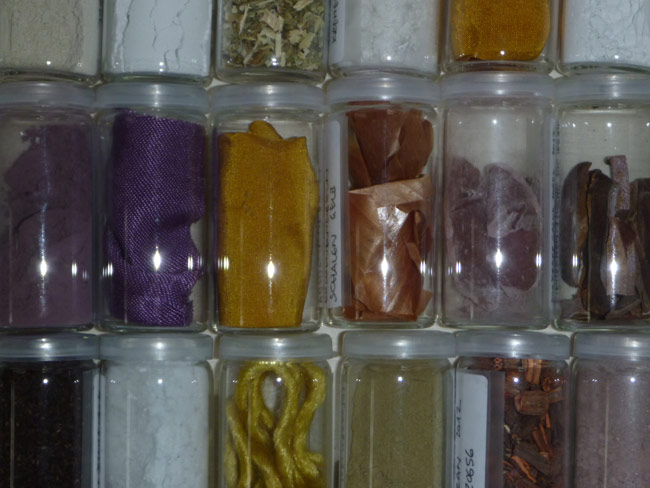
Excerpt of my
personal natural dye and pigment archive, Spring 2013
|
| |
My research approach:
My research approach is an artist's research approach, although I have also a background in scientific research. In general I'm working topic oriented. Depending on the topic, my research methods change, and might origin from different research contexts.
My research evolves mainly in art work, exhibition projects and other artists' publications, as well as in design projects for communicating science (solid state chemistry, crystallography), and art or natural science related education projects. |
| |
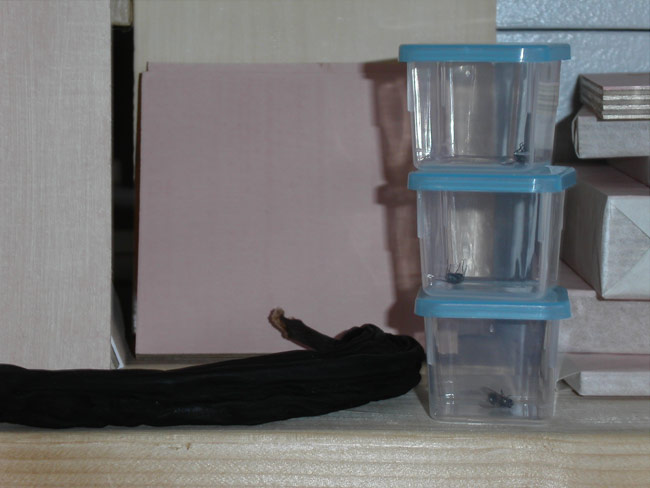
Anke Zürn, atelier situation, Zürich 2002
|
| |
|
|
Notes on the context depending meanings of some terms in "ART MATERIALS RESEARCH":
Depending on the research context, unfortunately some terms have different meanings.
I use the term "ARTISTS' MATERIALS RESEARCH" here for labeling artists' research on materials. This is sometimes also referred to as "ARTISTIC MATERIALS RESEARCH", "ART BASED MATERIALS RESEARCH" or "MATERIALS RESEARCH IN THE CONTEXT OF ART".
In the context of science "ARTISTS' MATERIALS RESEARCH" refers in general to scientific research on materials, destined for being used by artists.
The term "ARTS MATERIALS RESEARCH" in general means scientific research, when used in the context of the natural sciences, whereas when used in the context of art, it includes also artists' research approaches.
Also the idea of what is a research result might differ completely in the context of science and the context of art. For example the creation of contradictive feelings through the perception of an art work could be considered as an artist's research result.
Personal consequences:
When leaving the Laboratory of Inorganic Chemistry at ETH Zürich (where I was employed for 11 years as a scientist) and starting my free-lancing artist work again in Biel/Bienne in 2012, I consciously also left the context of scientific research to be able to operate again in the context of artists' research.
I define myself as an artist researcher, but when publishing a scientific topic in a scientific journal, I still follow the "rules" of scientific research. |
| |
Materials research: |
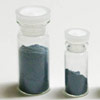 |
|
The term "MATERIALS RESEARCH" is commonly used for the research around the synthesis, structures, properties and use of materials. Art, design and architecture as well as the natural sciences and engineering sciences take equal part and interest in "MATERIALS RESEARCH", which means: They all explore materials and their properties, develop strategies for the synthesis and the creation of new materials, adjust materials’ fabrication processes, tune materials’ properties, question possible new applications, and extend the traditional use of materials. |
Pigment samples. |
|
| |
Artists' materials research versus scientific materials research
"ARTISTS' MATERIALS RESEARCH" operates also outside standardized and "objective" experimental setups. Art based research has thus the additional possibility to also include non-repetitive approaches, non standardized experimental setups and subjective, personal criteria. This is the main difference to "SCIENTIFIC MATERIALS RESEARCH".
... to my opinion, the advantage of researching in the context of art is, that artists' research methods can include all scientific research methods, whereas science has to exclude certain artists' research methods, as science is obliged to guarantee the reproducibility of its research results...
Researching in the context of art gives thus the possibility to also explore topics such as the uniqueness of a material or a situation, site specificity, personal connotations of materials and there use, non repetitiveness of situations, as well as to use non standardized or even irrational working processes.
... artists' materials research exactly has its excellence in the conduction of non-reproducible experiments and studies, to also explore topics such as the uniqueness of a material... |
| |
Art materials research: |
|
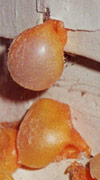 |
|
In "ART MATERIALS RESEARCH" - when operating in the context of art - the term "MATERIAL" might be used in a broader and often also abstract sense, including all "matter" used and/or researched on for the creation of art work or materials used and researched on in the context of art. The term "ART MATERIALS RESEARCH" thus might also include research topics such as personal relations to materials, possible connotations of materials and their use, site specificity and meanings, as well as intangible materials, such as ideas, thoughts, feelings, souvenirs, or dreams.
For a discussion on "art materials research", please have a look on the website of the Competence Center for Art Materials Research of the Lucerne University of Applied Science and Art. |
Left:no title (Zur Natur der Schimmelpilze), Anke Zürn,
chewing gums, pavilion of the art class, Gesamtschule Gartenstadt,
Dortmund, 2000;
in the framework of "Projekt G" (gART-Projekt in 2000) |
| |
|
|
Felt knowledge & sensual and visual research methods, visual thinking and thinking through doing: |
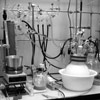
Laboratory situation in chemistry |
|
Sensuous and visual research methods are important for all disciplines involved in materials research, as is the development of manual skills. This is mirrored e.g. in the obligatory practical laboratory respectively atelier work in the curricula of the different disciplines involved in materials research.
In materials research also the communication of the research process and research results refer often to common, respectively historical practical experiences, achieved in the concerned research community. |
| |
| |
|
|
Visual communication: |

|
|
For communicating the complex topics around materials and materials properties, the visual communication has a long tradition, and the different research communities developed distinct visual languages, models, symbols and codes (see e.g. visuals for communicating chemistry). |
| |
|
|
| |
Artists publications versus scientific publications:
Artists' publications could be performances, visuals, site specific installations and interventions, such as concerts, exhibitions or theater- and dance performances, and thus also manifest in temporary events.
Artists' publications do not necessarily use written words but could include all sort of sensuous perceptions related to e.g. sound, smell, space, light, color.
Artists therefore explore different formats to communicate and publish their research, depending on research topic and the personal approach. Thus it is a real challenge to communicate artists' research in form of a "journal". One of the rare "journals" which tries to overcome the constraints of mainly word based publications is "The Journal for Artistic Research" (JAR), which aims of displaying practice in a manner that respects artists' modes of presentation. |
| |
Personal note on scientific research versus artists' research:
I believe the discussion on art-science-research-differences might be reduced on a discussion on "context relationships" and "habits", "behaviors" or "rules" inside different research communities, which are certainly not static, and changed a lot in history.
There is not "the sciences" or "the arts" as such, and research methods as well as the different "disciplines" and their "languages" are under constant reconsideration. Doing research means to also constantly request research methods, research habits and "research rules" in order to get new insights, to find something new, or to do something new.
Discussions on research methods and also on the relevance of research (respectively research results) evolve especially, when crossing the boundaries of distinct research communities, when speaking different "research languages" (e.g. visual versus verbal), when referring to a different community knowledge or experience, or when (re)questioning traditions.
Up to now the scientific community still has difficulties handling sensuous research approaches and especially irrational and subjective approaches of the artists' research community, as scientific research is obliged to objectivity and rational arguments only, and to work with methods which ensure the reproducibility of an experiment or a study. Also ambiguous or multivalent results or feelings are difficult to handle or communicate within a rational system.
To my opinion it is difficult today to conduct artist research in the context of science, but it is perfectly possible to conduct scientific research in the context of art, as artist research allows for rational and objective approaches as well as irrational and subjective approaches. This might be the main difference.
Else I believe, that it is time to forget about disciplines and to simply research!
Anke Zürn |
| |
|
|
|
|
| |
November 2013
Symposium
GRENZGÄNGE ZWISCHEN WISSENSCHAFT UND KUNST
15.–16. November 2013
Wien
Anmeldung
October 2013
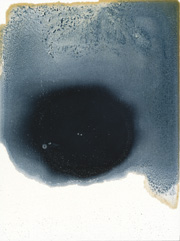
MERCI & DANKE !!!!
I received a working grant by the city of Biel/Bienne for my project "AROUND LAKE BIEL". The project will start in March 2014. |
| |
| Visual blog: |
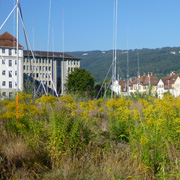
September 2013, canada golden-rod Solidago canadensis is flowering in Biel/Bienne.
> blog
|
| |
| New address: |
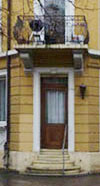
Labor für
Struktur und Farbe
General Dufourstrasse 138
CH-2502 Biel/Bienne
Switzerland
|
| |

The United Nations has declared 2014 as the International Year of Crystallography
More information on the IUCr website |
| |
|